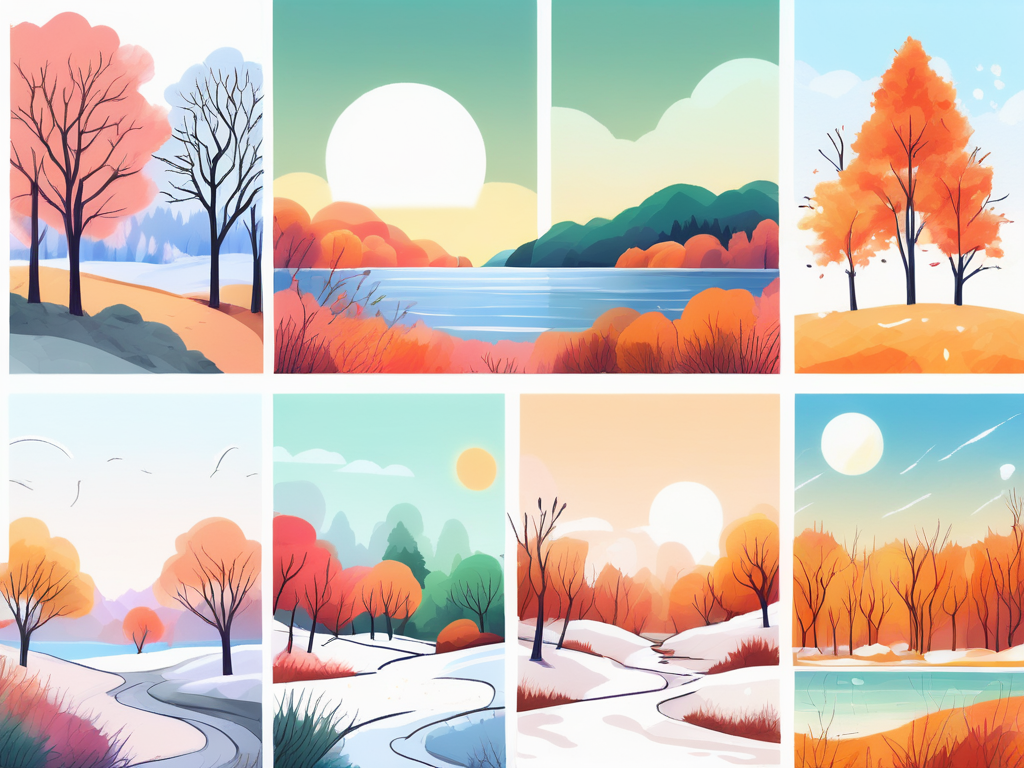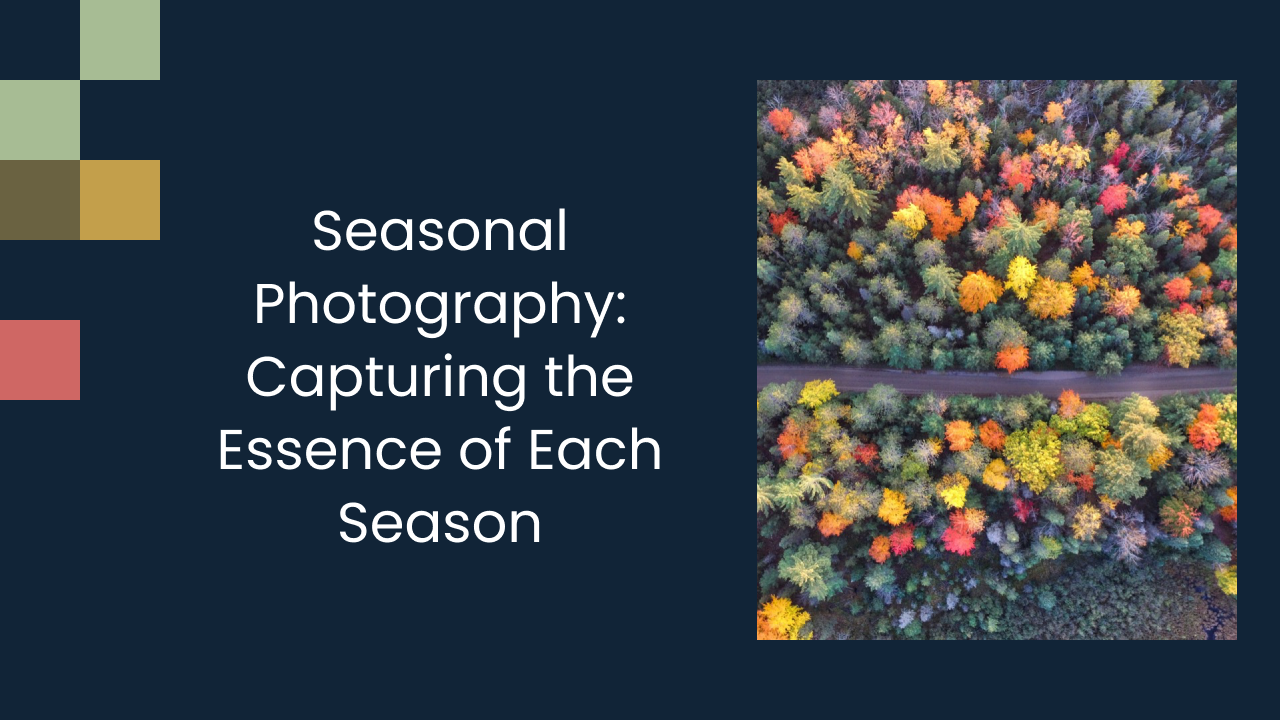Seasonal Photography: Capturing the Essence of Each Season

Seasonal photography is a captivating art form that allows photographers to capture the essence of each season. By understanding and observing seasonal changes, photographers can use different techniques to bring out the unique beauty of each season. In this article, we will explore the art of seasonal photography, the importance of capturing the seasons, techniques for capturing each season, and the essential equipment needed for this type of photography.
Understanding Seasonal Photography
Seasonal photography is the art of capturing the beauty and spirit of each season through photographs. It goes beyond taking snapshots of landscapes and focuses on telling a story about the season. This form of photography allows us to appreciate the changes that occur from winter to spring, spring to summer, summer to autumn, and autumn to winter.
Each season brings its own unique color palette, lighting conditions, and atmosphere. Winter is characterized by crisp air, bare trees, and glistening snow, creating a serene and tranquil landscape. Spring bursts forth with vibrant blooms, fresh greenery, and a sense of renewal and growth. Summer dazzles with bright sunshine, clear skies, and bustling outdoor activities, evoking feelings of warmth and vitality. Autumn envelops us in a symphony of warm hues, falling leaves, and a sense of nostalgia as nature prepares for winter's slumber.
What is Seasonal Photography?
Seasonal photography involves capturing images that reflect the distinct characteristics of a particular season. It can include landscapes, nature, weather patterns, people engaged in seasonal activities, and the overall mood of the season.
The Importance of Seasonal Photography
Seasonal photography is important because it allows us to document the passing of time and appreciate the beauty of nature's cycles. It helps us connect with the natural world and cultivates a deeper understanding and respect for the environment. Additionally, seasonal photography provides an opportunity for self-expression and creativity.
Through seasonal photography, we can explore the intricate details of each season, from the delicate frost patterns on a winter window to the vibrant fall foliage reflected in a tranquil lake. By immersing ourselves in the essence of each season, we gain a greater appreciation for the world around us and find inspiration in the ever-changing tapestry of nature.
The Art of Observing Seasonal Changes
Observing seasonal changes is essential for capturing the true essence of each season in your photographs. By paying attention to the following aspects, you can create meaningful and visually stunning images:
Recognizing Seasonal Elements
Each season has its own unique elements that define its character. For example, vibrant flowers and blossoms are associated with spring, while vibrant colors and falling leaves represent autumn. By understanding and highlighting these elements, you can showcase the beauty of the season in your photographs.
Spring brings a burst of new life with blooming flowers and fresh greenery. It's a time of renewal and growth, symbolized by the delicate petals of cherry blossoms and the lush green leaves of trees. Capturing the essence of spring involves focusing on the vibrant colors and the sense of rejuvenation that permeates the air.
The Role of Weather in Seasonal Photography
Weather plays a significant role in influencing the mood and atmosphere of each season. It is essential to take weather conditions into account when planning your seasonal photography sessions. Rain, fog, snow, or sunshine can dramatically affect the outcome of your photos and create different moods and emotions.
Autumn, with its crisp air and changing foliage, offers a rich tapestry of colors and textures for photographers to explore. The golden hues of falling leaves and the soft light filtering through the trees create a nostalgic and serene atmosphere. Embracing the weather elements of autumn, such as the gentle mist on a cool morning or the warm glow of sunlight on a brisk day, can add depth and emotion to your seasonal photographs.
Techniques for Capturing Each Season
Each season requires unique techniques to capture its essence effectively. Here are some techniques to help you photograph each season:
Spring Photography Techniques
In spring, utilize macro photography to capture the beauty of flowers and blossoms up close. Experiment with depth of field to isolate your subject and create a soft, dreamy background. Capture the freshness and renewal of the season by photographing raindrops on petals and capturing the vibrant colors of nature awakening.
Furthermore, spring is a time of new life and growth. Look for opportunities to capture baby animals, such as ducklings swimming in a pond or a nest of chirping birds. These precious moments will add a touch of sweetness to your spring photography collection.
Summer Photography Techniques
During summer, take advantage of the longer days and shoot during the golden hours - early morning and late afternoon when the light is soft and warm. Capture the energy and joy of summer by photographing people enjoying outdoor activities, vibrant landscapes, and stunning sunsets.
Moreover, summer is a season of abundance. Explore local farmers' markets and capture the vibrant colors and textures of fresh fruits and vegetables. From juicy watermelons to plump tomatoes, these images will make your viewers' mouths water and evoke the taste of summer.
Autumn Photography Techniques
Autumn is known for its vibrant colors and falling leaves. Incorporate these elements into your compositions by using leading lines and framing techniques to guide the viewer's eye. Experiment with capturing the warm tones of autumn by shooting during the golden hour. Take advantage of mist and fog to create a moody and mysterious atmosphere.
In addition, autumn is a time of harvest and celebration. Seek out local festivals and capture the joyous spirit of people coming together to enjoy seasonal activities like apple picking, pumpkin carving, and hayrides. These images will transport your viewers to the heartwarming traditions of autumn.
Winter Photography Techniques
Winter offers unique opportunities for minimalist and monochromatic photography. Embrace the stark beauty of snow-covered landscapes and capture the stillness and tranquility of the season. Experiment with long exposure photography to capture falling snowflakes or frozen water bodies.
Furthermore, winter is a season of coziness and warmth. Seek out scenes of people bundled up in scarves and hats, sipping hot cocoa by a crackling fire, or engaging in winter sports like ice skating or skiing. These images will evoke a sense of comfort and nostalgia, reminding your viewers of the simple pleasures of winter.
Essential Gear for Seasonal Photography
Having the right gear is crucial for capturing stunning seasonal photographs. Here are some essential equipment items to consider:
Choosing the Right Camera
Invest in a camera that suits your needs and preferences. Look for features such as a high-resolution sensor, weather sealing, and fast autofocus to handle various lighting and weather conditions.
When selecting a camera for seasonal photography, consider the importance of portability and durability. A lightweight camera body can be advantageous when hiking to remote locations to capture the changing seasons. Additionally, weather sealing is essential to protect your camera from rain, snow, and dust, ensuring it remains in optimal condition throughout the year.
Lenses for Different Seasons
Choose lenses that are suitable for the specific type of photography you intend to capture in each season. Wide-angle lenses are ideal for capturing vast landscapes, while macro lenses are perfect for close-up shots of flowers and details.
For winter photography, consider investing in a telephoto lens to capture wildlife from a distance without disturbing their natural habitat. In contrast, for spring photography, a prime lens with a wide aperture can beautifully isolate flowers against a soft, blurred background, adding a dreamy quality to your images.
Additional Equipment for Seasonal Photography
Consider investing in additional equipment such as a tripod for stable shots, filters to enhance the colors and contrast in your images, and a waterproof cover to protect your gear during inclement weather conditions.
A tripod is indispensable for long exposure shots during autumn, capturing the vibrant colors of falling leaves in a mesmerizing blur. Polarizing filters can reduce glare from snow or water surfaces in winter photography, while neutral density filters are essential for achieving balanced exposures in harsh midday sunlight during summer.
Capturing the essence of each season through photography allows us to appreciate the beauty and uniqueness that each season brings. By understanding seasonal photography, observing seasonal changes, using appropriate techniques, and having the essential gear, you can create stunning images that celebrate nature's cycles and evoke a sense of wonder and awe. So grab your camera and venture out into the ever-changing world of seasonal photography!
Looking for an easier way to manage and grow your studio? Experience a platform built by a photographer, for photographers. Try it free for 2 weeks.











